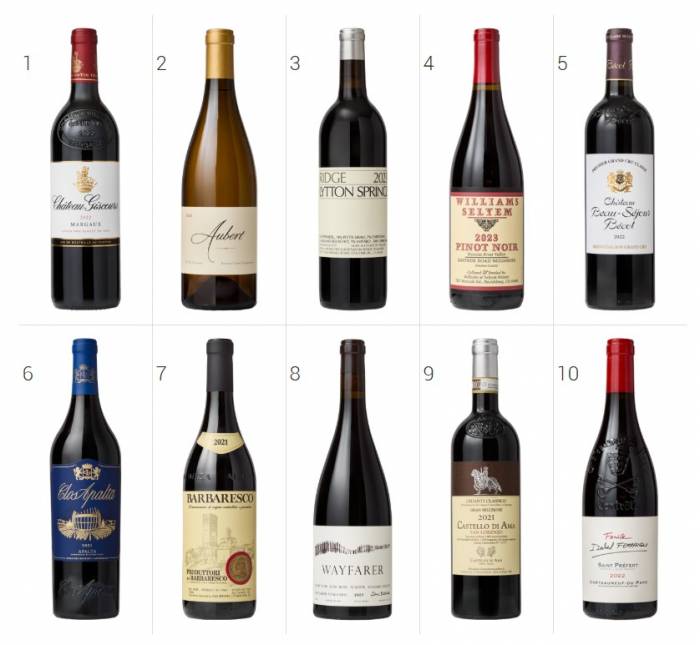葡萄酒观察家》2025 年百佳葡萄酒中有 38 款首次亮相,平均得分 93 分
酒单中加州和法国葡萄酒占主导地位,其中 14 款超过 100 美元,34 款低于 30 美元,反映了不断变化的全球趋势
2025年 11月 18日

葡萄酒鉴赏家》(Wine Spectator)发布了 "2025 年百佳葡萄酒 "榜单,该榜单反映了过去一年全球葡萄酒行业的趋势、挑战和成就。该年度排名于 11 月 17 日公布,其依据是杂志编辑进行的盲品,他们对整个 2025 年的 10200 多款葡萄酒进行了评测。其中,5500 多款葡萄酒获得了 90 分或更高的评分,形成了最初的候选名单。
编辑们对葡萄酒的质量、价值、可获得性以及他们所称的 "X因素"--每瓶葡萄酒背后的精彩故事--进行了评估。今年的榜单既有来自世界各地的知名生产商,也有新兴酒庄。在经济不稳定和消费者偏好不断变化的这一年,榜单也彰显了酿酒师们的坚韧不拔。
来自波尔多的 Château Giscours Margaux 2022 今年荣登榜首。加州奥贝尔霞多丽索诺玛海岸 UV-SL 葡萄园 2023 和 Ridge Lytton Springs 干溪谷 2023 紧随其后。加州 2023 年份葡萄酒在榜单中表现突出,尤其是黑皮诺、霞多丽和仙粉黛。法国葡萄酒在经历了前一年的挑战后,在其 2022 年份的成功推动下卷土重来。意大利葡萄酒也表现不俗,约占参赛酒款的 20%。
参评产区范围广泛。100 强中既有波尔多、勃艮第、托斯卡纳和里奥哈等经典产区的葡萄酒,也有俄勒冈威拉米特谷和新西兰马尔堡等新兴热点产区的葡萄酒。今年有 38 款葡萄酒首次上榜,还有一些葡萄酒在多个年份都表现出了卓越的品质。
入选葡萄酒的价位差异很大。有 14 款葡萄酒的价格在 100 美元或以上,但也有 34 款葡萄酒的价格在 30 美元或以下。100 强葡萄酒的平均得分为 93 分,平均价格为每瓶 58 美元。
评选过程还考虑了美国市场的供应情况。葡萄酒的产量或进口量必须足以让美国消费者买到。这种方法确保了榜单不仅是品质的展示,也是买家的实用指南。
有几家生产商的多款葡萄酒获得了认可,但为了保持排名的多样性,每家生产商只能有一款葡萄酒入选。榜单包括红葡萄酒和白葡萄酒、香槟和普罗塞克等起泡酒,以及桃红葡萄酒和黄褐色波特酒等甜酒。
今年的百强榜反映了全球葡萄酒生产和消费的持续变化。气候条件影响了许多地区的葡萄酒质量。经济压力导致一些酒庄在不牺牲质量的前提下,将重点放在以价值为导向的产品上。与此同时,人们对历史悠久的酒庄以及创新的新项目重新产生了兴趣。
葡萄酒观察家》的年度榜单被广泛认为是美国葡萄酒鉴赏和购买趋势的晴雨表。排名公布后,零售商对特色葡萄酒的需求往往会增加。
完整榜单可在《葡萄酒鉴赏家》网站上查阅,其中包括每款葡萄酒的详细品鉴说明。对于收藏家和休闲饮酒者来说,今年的 100 强榜单提供了当下令人兴奋的葡萄酒--从经典品牌到新发现--不同价格和风格的葡萄酒。
Vinetur® 是 VGSC S.L. 公司的注册商标,成立于 2007 年,在葡萄酒行业有着悠久的历史。
VGSC,S.L.(CIF B70255591)是一家在西班牙圣地亚哥-德孔波斯特拉商业注册处注册的实体。
电子邮件:[email protected] | 电话:+34 986 077 611
总部和办事处位于加利西亚的 Vilagarcia de Arousa